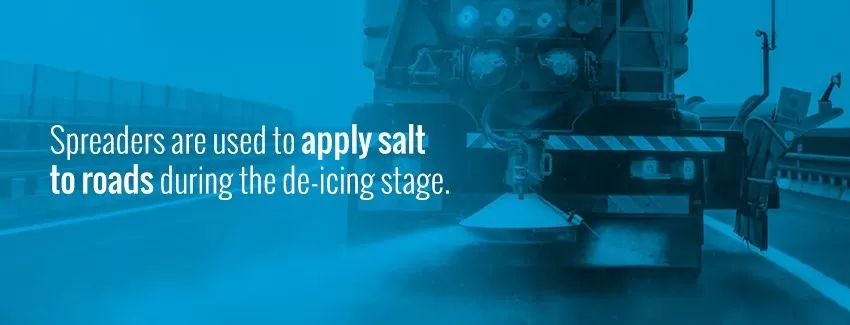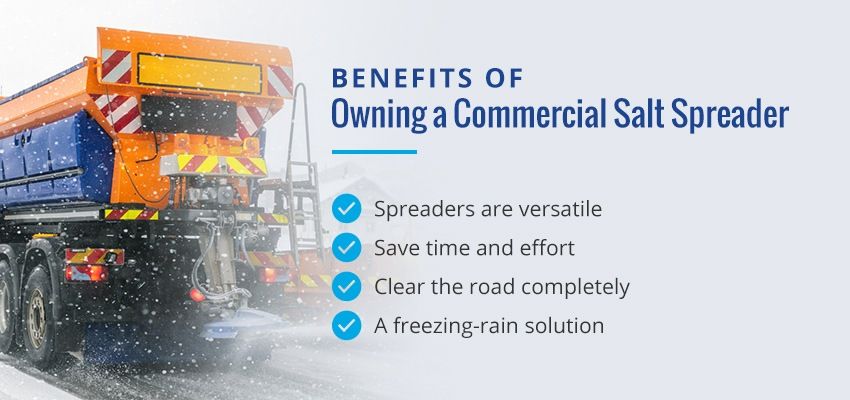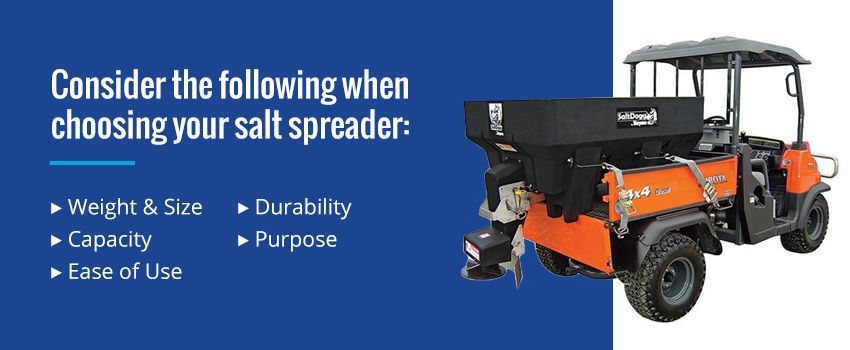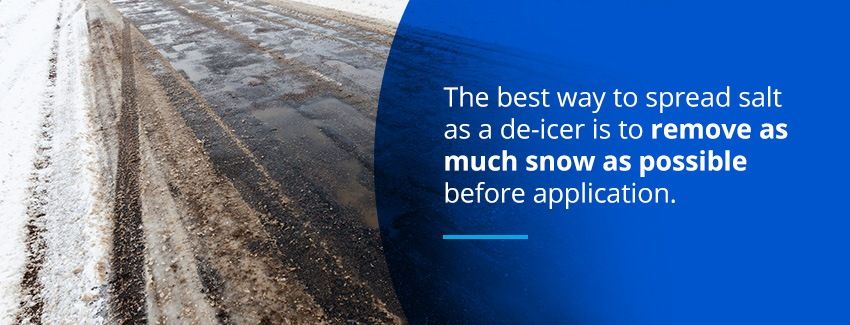What Are Salt Spreaders?
Feb 26, 2020Last Updated on September 30, 2024 by Alex Bobb
Last Updated on September 30, 2024 by allprotrailersuperstore
It’s true — nothing beats a plow when it comes to snow removal. However, if you want to get down to the bare pavement, you’ll need some assistance. This is where salt spreaders come in handy.
You’ve probably walked on a salt-covered sidewalk before during the winter. Chances are, you appreciated walking on salt rather than slipping on ice. Believe it or not, Americans were not too happy about road salt when it first appeared as a snow-removal tool in the 1800s. Salt damaged the shoes and clothing of pedestrians and made the streets unsuitable for sleigh drivers.
During the 20th century, cities realized that salt was more effective when applied to ice and light snowfall rather than tossed on piles of snow. With plows leaving behind layers of ice, consumers were demanding salt and sand to make the roads safer for traveling. Soon, businesses and residents were throwing tons of salt on driveways and sidewalks to keep them ice-free. Cities
initially salted the roads by shoveling salt out of the beds of trucks, which was physically demanding.
Eventually, spreaders were attached to trucks to distribute fertilizer for agricultural purposes. Today, spreaders are designed to distribute salt efficiently at controlled flow rates and high speeds.
Salt spreaders are a crucial component of winter road maintenance and are often used in conjunction with plows. Salt lowers the freezing point of water and ultimately prevents ice formation.
In this chapter, we’ll show you how salt spreaders work, the different types of spreaders available and how to choose the right device for your vehicle.
Table of Contents
- What Are Salt Spreaders and How Do They Work?
- Types of Spreader Equipment
- The Benefits of Owning a Commercial Salt Spreader
- Tips for Choosing a Salt Spreader
- The Best Way to Spread Salt
What Are Salt Spreaders and How Do They Work?
A salt spreader is a device used to distribute a solid material on the road. A salt spreader attaches to the rear of a vehicle and disperses salt or sand as the vehicle moves along. Typically the operator will use sodium chloride in the form of solid rock salt. Calcium chloride, potassium chloride and magnesium chloride are other options.
Once a spreader is mounted onto a truck, the operator fills the hopper with salt and turns it on. Operators control the auger and spinner from inside the cab to regulate how much of the material is spread per mile. The auger pulls the material, such as salt, from the hopper towards the discharge chute. The spinner disk distributes the salt over a wide area.
Spreaders are used to apply salt to roads during the de-icing stage. Deicing occurs after snow and ice have already accumulated and bonded with surfaces. Salt is not meant to melt snow, but rather keep it from adhering to the pavement. It can be difficult to remove ice from roadways without the use of de-icing materials, nor is it suitable for a plow. De-icing chemicals must
be used to break the bond between ice and the road.
Generally, you’ll want to plow snow and loose ice before applying de-icing materials. However, you might spread salt during a snowstorm to make it easier to clear ice and snow with a plow afterward if the conditions are right.
Salt loses its effectiveness as temperatures drop. For example, at 10 F, it takes an hour for salt to melt a 1/8-inch-thick layer of ice. The Minnesota Department of Transportation recommends not using salt at temperatures below 15 F because it won’t melt fast enough, and it’s not cost-effective. When it’s too cold for salt to work, you can use your spreader to apply sand or another abrasive material. Sand will not melt anything, but it will make surfaces less slippery. It’s best only to use sand when necessary because it clogs sewers and ditches. You might use a salt-sand mix during freezing rain to help keep salt from washing away. Otherwise, it’s not recommended to use a blend because salt makes sand less effective.
Types of Spreader Equipment
Like plows, spreaders are available in a range of sizes and shapes for various applications. Types of salt spreaders include:
- Tailgate spreaders: Tailgate spreaders feature high-capacity hoppers and mount on the rear of a vehicle. Tailgate spreaders are considered dependable and straightforward and are perfect for keeping the bed of your truck open.
- In-bed spreaders: In-bed, or V-box, salt spreaders are popular commercial salt spreaders commonly used by professionals. These types of spreaders sit in the bed of a truck and feature various moving parts. In-bed spreaders are ideal for big projects.
- Tow-behind spreaders: Tow-behind spreaders are pulled by a vehicle or tractor. They are better at covering a large area than a walk-behind spreader but are less accurate than a tailgate or in-bed spreader.
- Walk-behind spreaders: A walk-behind spreader looks and functions similar to a wheelbarrow and requires you to push the hopper with a handle and two wheels. A walk-behind spreader is an excellent choice for salting sidewalks or tight spaces.
At Trailer Superstore, you’ll find high-quality SaltDogg tailgate and in-bed spreaders to help you cover driveways, parking lots and more.
The Benefits of Owning a Commercial Salt Spreader
Simply said, salt spreaders keep ice from sticking to the pavement and therefore reduce accidents. For maximum snow removal, you need a salt spreader to complement your plow.
Here are more reasons why it’s worth adding a salt spreader to your arsenal of winter tools:
- Spreaders are versatile: Spreaders have multiple applications and allow you to spread various materials. For example, you can use the same spreader to apply sand over snow-covered surfaces as you use for salt, so you don’t need to buy a separate device.
- They save time and effort: Although you can grab a bag of salt and coat your parking lot by hand, is it really something you have time for when your business needs to open in 10 minutes? A salt spreader gets the job done fast and doesn’t require you to freeze your hands.
- Salt spreaders clear the road completely: Plows can’t clear the road down to the bare pavement, but salt spreaders can. Therefore, without a salt spreader, you’ll still have a slick parking lot or driveway and risky conditions for employees, customers and guests.
- Spreaders are a freezing-rain solution: Unfortunately, you can’t plow freezing rain, which can be a problem. Freezing rain causes icy pavement, which leads to about 520 deaths a year and over 150,000 car crashes. A salt spreader gives you the power to clear roads during freezing rain.
Tips for Choosing a Salt Spreader
If you live in a snowy area, you’ll get a lot of use out of a salt spreader. But, that doesn’t mean any type of spreader will do.
You’ll need to consider various factors when choosing the best spreader for your applications, such as the size of your vehicle, the surface you’ll be clearing and the material you’ll use.
Make sure to consider the following:
- Weight and size: If you choose an in-bed spreader, you’ll need to keep in mind you’ll be placing it in the bed of your truck, while a tailgate salt spreader will be mounted to the back. Choose a spreader that your vehicle is capable of hauling in harsh weather conditions.
- Capacity: Think about the capacity you need for the route. You’ll have to consider the size of the area you need to cover. Tailgate or in-bed spreaders are both great options for big jobs or commercial routes, whereas a walk-behind spreader makes the most sense for sidewalk applications.
- Ease of use: Choose a spreader that’s easy to load, attach and operate so you can start using your equipment right away.
- Durability: A salt spreader should be durable and resistant to corrosion. Just like your plow, your salt spreader is an investment that should last you many years. It’s worth prioritizing quality over savings as you shop because you’ll spend less on replacement parts and repairs in the long run.
- Purpose: Choose the right device for the job, and consider whether you need a commercial salt spreader or one for personal use.
Still have questions? We can help you choose the best salt spreader for your vehicle and salting requirements.
The Best Way to Spread Salt
The best way to spread salt as a de-icer is to remove as much snow as possible before application. Remember, salt does not melt snow — it keeps ice from bonding with pavement.
Also, keep in mind that salt must mix with water to prevent ice formation, so there’s no need to spread more than what’s necessary. According to the Wisconsin Transportation Information Center, it’s most effective to spread 100 to 300 pounds of salt per single lane mile. Other tips to remember include:
- Spread salt sparingly in high foot traffic areas.
- Properly store salt to keep it dry — it should not have a moisture content of greater than 1.5%.
- Use just enough salt to break the bond between snow and ice so it can be plowed.
- If possible, salt before it snows or when a storm begins to keep snow or ice from sticking to the pavement.
- Consider the temperature — salt won’t work if the pavement temperature is below 15 F.
- Make sure spreading equipment is properly calibrated to prevent oversalting and protect the environment.
- Turn off the auger whenever you stop, even if just for a moment.






